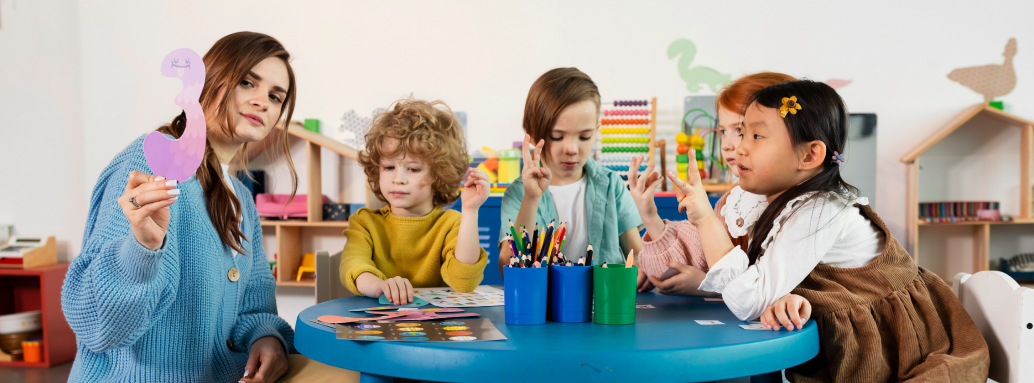In the realm of early childhood education and development, fostering positive communication between parents and teachers is paramount. Effective parent-teacher communication can lead to enhanced learning experiences for children, improved classroom dynamics, and a supportive environment for young learners. In this article, we will delve into the essential strategies for encouraging positive parent-teacher communication, exploring ways to establish strong partnerships between these two crucial stakeholders in a child's educational journey.
As we navigate the intricate world of early childhood education, the bond between parents and teachers emerges as a crucial element. Let's delve into why this synergy is not just beneficial but essential for our little learners' growth and how, through strategic steps, we can strengthen this alliance.
The Importance of Parent-Teacher Communication
At the core of a child's education is the unique collaboration between home and school. Effective communication between parents and teachers can significantly enhance a child’s academic and social development. But why is this dialogue so critical? It boils down to two-way insights: teachers gain a more holistic view of the child, while parents can understand and reinforce educational objectives at home. Before we delve into the strategies, let's first understand why positive parent-teacher communication is so vital in early childhood education.
1. Building Trust and Collaboration
Effective communication builds trust between parents and teachers. When parents feel heard and respected, they are more likely to collaborate with teachers to support their child's learning.
2. Better Understanding of the Child's Needs
Through regular communication, teachers gain insights into a child's home environment, enabling them to tailor their teaching strategies to meet individual needs effectively.
3. Enhancing Child's Development
When parents and teachers work together, they create a more comprehensive support system for the child, which can result in improved cognitive, social, and emotional development.
The Impact on Child Development
The harmony between a parent's nurturing and a teacher's educational prowess can lead to wonders in a child's life. When parents and educators are in sync, children receive consistent messages about their value and potential, fostering a robust foundation for learning and development.
1. Understanding Communication Barriers
Before we can build bridges, we must understand what divides us. Communication between parents and teachers can sometimes hit a wall due to various factors ranging from time constraints to cultural misunderstandings.
2. Common Challenges in Parent-Teacher Interactions
Parents and teachers often face hectic schedules, language barriers, and differing expectations. Recognizing these challenges is the first step towards creating a more inclusive and effective communication pathway.
3. Overcoming Misconceptions and Cultural Differences
Every parent-teacher relationship is colored by individual experiences and cultural backgrounds. It's crucial to embrace diversity and seek common ground through empathy and understanding.
4. Setting the Stage for Effective Communication
The first interaction between parents and teachers can set the tone for future communication. How can we ensure this foundation is strong?
5. Establishing Initial Contact
A warm, welcoming initial contact can do wonders. Whether it's an orientation day or a personal note home, these gestures make a lasting impression and pave the way for open communication.
6. Creating a Welcoming Environment
Schools and classrooms should feel like safe spaces for parents. This means being mindful about the physical space and the attitudes and language used within it.
Strategies for Positive and Ongoing Parent-Teacher Communication
Once the initial connections are made, nurturing those relationships becomes paramount. Consistent, clear communication is key. Now, let's explore some practical strategies to promote positive communication between parents and teachers.
1. Establish Open Lines of Communication
Initiate communication early in the school year to set the tone. Provide various channels such as email, phone, and in-person meetings, making it easy for parents to reach out.
2. Welcome Parents with Warmth
Create a welcoming and inviting atmosphere during parent-teacher conferences and meetings. A warm and friendly demeanor encourages parents to share their thoughts and concerns openly.
3. Active Listening
Listen attentively to parents' concerns and opinions. Give them the space to express themselves without interruption, showing empathy and understanding.
4. Be Clear and Transparent
Clearly communicate classroom expectations, curriculum, and assessment methods. Transparency helps parents feel informed and involved in their child's education.
5. Regular Updates
Scheduled meetings and regular updates prevent miscommunication and ensure that both parties are kept in the loop regarding the child's progress and needs. Provide regular updates on a child's progress, both academically and behaviorally. This can include progress reports, newsletters, or brief notes.
6. Parent-Teacher Conferences
Hold scheduled parent-teacher conferences to discuss a child's progress in detail. Encourage parents to prepare questions or topics they'd like to discuss during these meetings.
7. Use Technology
In our digital age, leveraging technology can be a game-changer for parent-teacher communication. Childcare management software, apps, and platforms dedicated to school-home communication can bridge gaps and fit into busy schedules. Utilize online platforms or apps to share information, assignments, and updates with parents in real-time.
8. Positive Feedback
Celebrate and acknowledge a child's achievements, no matter how small. Positive feedback creates a supportive and motivating environment for both parents and children.
9. Address Concerns Promptly
Address any concerns or issues promptly and professionally. Open communication during challenging times can prevent misunderstandings from escalating.
10. Parent Involvement
Encourage parents to get involved in the school community through volunteering, attending workshops, or participating in school events. This strengthens the parent-teacher partnership.
11. Cultural Sensitivity
Respect and embrace cultural diversity. Recognize and understand the unique backgrounds and values of each family to establish rapport and trust.
12. Set Clear Boundaries
While open communication is crucial, it's also essential to set clear boundaries to maintain professionalism and respect in the parent-teacher relationship.
Encouraging Parental Involvement
When parents are involved in school activities, the benefits are manifold. How can schools encourage this beneficial engagement?
Volunteer Opportunities
Offering various ways for parents to volunteer at school can significantly enhance the parent-teacher relationship and give parents insight into the educational environment.
Educational Workshops for Parents
Workshops that equip parents with the tools to support their children's learning at home can be powerful. It's an investment in the child’s educational support network.
Addressing Issues with Transparency
No relationship is without its hiccups. Addressing concerns with honesty and clarity can prevent misunderstandings and build trust.
Dealing with Concerns
When issues arise, it's important for teachers to approach parents proactively, with a problem-solving mindset, and for parents to listen and engage constructively.
Building a Trust-Based Relationship
Trust is the cornerstone of any relationship. In the parent-teacher dynamic, it's built through consistent, positive interactions and a shared commitment to the child's well-being.
Acknowledging Parental Expertise
Parents are experts when it comes to their children. Teachers who listen to and value parental insights can often tailor their approach to better meet the needs of the child.
Valuing Parental Input
Encouraging parents to share their observations and insights can lead to a more tailored and effective educational approach.
Collaborative Decision Making
When parents and teachers make decisions together, it reinforces the partnership and ensures that the child's best interests are always at the forefront.
Tailoring Communication Styles
Not all parents and teachers communicate in the same way. Adapting to preferences and needs is essential for effective communication.
Recognizing Individual Preferences
Some parents may prefer face-to-face meetings, while others might lean towards digital correspondence. Honoring these preferences can lead to more effective and comfortable communication.
Adapting to Various Communication Needs
Flexibility in communication styles is a mark of a responsive and inclusive educational environment.
Resources and Tools for Effective Communication
Thankfully, there are numerous resources and tools available to support parent-teacher communication.
Digital Platforms for Engagement
From classroom blogs to online report cards, digital platforms can offer convenient and consistent ways for teachers to share information and for parents to stay engaged.
Communication Workshops for Educators
Professional development in the form of communication workshops can equip teachers with the skills to engage effectively with parents from diverse backgrounds.
Evaluation and Feedback
Continuously improving communication strategies is essential for sustaining and growing parent-teacher relationships.
Gathering Feedback from Parents
Surveys and informal conversations can provide valuable insights into how parents perceive the communication efforts and where there's room for improvement.
Continuous Improvement of Communication Strategies
Using feedback to refine communication strategies ensures that the parent-teacher partnership remains strong and effective.
Celebrating Successes Together
Recognizing and celebrating the successes of students together can reinforce the positive impact of strong parent-teacher communication.
Sharing Positive Outcomes
When good news is shared, it strengthens the bond between home and school, showing everyone involved the tangible results of their cooperation.
Strengthening Community Bonds
Celebrating together fosters a sense of community and shared purpose, further enhancing the educational experience for children.
Legal and Ethical Considerations
While fostering open communication, it's vital to remain within the bounds of professionalism and confidentiality.
Confidentiality and Professional Boundaries
Teachers must balance open communication with the need to maintain student confidentiality and adhere to professional boundaries.
Navigating Difficult Legal Scenarios
In challenging situations, it’s crucial for teachers to be well-versed in the legal aspects of parent-teacher communication.
Preparing for Challenges
Despite best efforts, challenges will arise. Being prepared to handle them is part of building a resilient communication framework.
Crisis Management
Having a plan in place for emergencies ensures that communication remains clear and effective, even in difficult times.
Conflict Resolution Skills
Conflict is natural, but the ability to resolve it amicably and effectively is a skill that can be developed and honed.
Training and Professional Development
Investing in ongoing training for teachers can pay dividends in the quality of parent-teacher communication.
Enhancing Communication Skills
Workshops, courses, and peer-learning opportunities can all contribute to building a teacher’s communication repertoire.
Workshops and Courses for Teachers
Structured learning opportunities allow teachers to continually improve their communication skills, making them even more effective in their interactions with parents.
Conclusion
Effective parent-teacher communication is the cornerstone of a successful early childhood education experience. By implementing these strategies, educators can build strong partnerships with parents, creating a collaborative environment that benefits the child's development and academic journey.
In conclusion, the journey of fostering effective parent-teacher communication is ongoing and dynamic. It requires patience, understanding, and a willingness to adapt. By acknowledging and addressing the barriers, celebrating the successes, and continuously seeking improvement, we can create a thriving environment where children benefit from the collective support and wisdom of their parents and teachers. It's a partnership where the ultimate winner is the child, who receives a cohesive and supportive educational experience.
Now, let’s look at some common queries that might arise on this topic.
FAQs
1. How often should parents and teachers communicate? Regular communication is key, but the frequency can vary depending on the needs of the child and the preferences of the parents and teachers. Some might prefer weekly updates, while others may find monthly meetings sufficient.
2. What is the best platform for parent-teacher communication? The "best" platform depends on what is most accessible and comfortable for both parties. Many schools use specialized apps or platforms, but some may rely on email, phone calls, or in-person meetings.
3. How can teachers ensure they respect cultural differences in communication? Teachers can respect cultural differences by being culturally responsive, seeking to understand the family's background, and being open to adapting communication styles to meet parents' needs and comfort levels.
4. What can parents do if they feel communication with teachers is not effective? Parents should feel empowered to reach out and express their concerns. Setting up a meeting to discuss communication preferences and how to improve the dialogue can be beneficial.
5. Can too much communication become counterproductive? Yes, there is a balance to be found. Overcommunication can lead to information overload and can become overwhelming for both parties. It's important to establish what is necessary and to respect each other’s time.
Billing, Invoicing Automation & Smart Finances
Communication & Engagement
Child Development & Progress
Waitlist, Forms & Attendance
Effortless Team Management
Daily Updates That Matter
Templates & Printables
Blogs
Webinars
Case Studies & Testimonials
FAQs
Help Center


